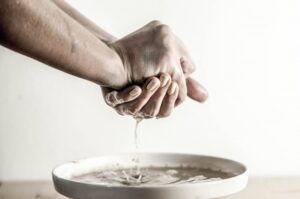How to make porcelain clay casting plasma (with video explanation)

Hello, this is Fuchino.
In this video, I will show you how to make porcelain clay casting mud plasma.
The clay I used was heat-resistant No. 60.
The quantities were
33 kg of soil (the moisture content of the clay is about 78%)
4 liters of water
20cc of sodium silicate No. 1 (40cc of the double solution used in the video)
In our case, we dilute the sodium silicate to 2 times with water for ease of use.
This amount will make 18 to 19 liters of casting mud.
A 30-liter container is used to make the plasma.
First, put sodium silicate and water in this container, and turn the stirrer.
The speed of the blades should be about 200 revolutions per minute.
If it is too slow, it will not mix well, and if it is too fast, too much plasma will be scattered.
Still, some of the plasma will bounce around, so close the lid.
If you close the lid completely, you won’t be able to fill it with clay.
I made a notch in the lid to make room for the clay.
Insert the clay through this gap.
Divide the entire amount of clay into thirds and melt them together.
If you put all the clay in at once, there will be a lot left over.
Cut the first 1/3 of the clay into small pieces and add them.
After adding the first 1/3 of the clay, stir it for about an hour and wait for it to dissolve.
Checking the progress of the cast plasma.
After the time has passed, speed up the speed of the stirrer to about 250 revolutions per minute and
Cut the next 1/3 of the clay into small pieces and add them.
When you have finished adding the clay, stir the mixture as you did with the first 1/3 for about 1 hour and wait for it to dissolve.
After that, increase the speed of the stirrer to about 300 revolutions per minute and add the remaining 1/3 of the clay.
After the remaining 1/3 of the clay is cut into small pieces and added, all the clay is ready to be added.
Keep stirring for about an hour and wait for it to dissolve.
When the mixing is finished, stop the stirrer and put your hand in the mud.
After the mixing is complete, stop the stirrer and put your hand into the plasma to check for any remaining dissolved material.
In a cylindrical container such as a bucket
In a cylindrical vessel such as a bucket, the residue often sticks to the inner walls and the periphery of the bottom.
If there is such residue, remove it by hand.
If the residue is large, crush it by hand to make it smaller so that it can be dissolved easily.
Once all the residue has been processed, pull your hands out of the plasma and run the stirrer again.
It will depend on the amount of residue.
Again, depending on the amount of residue, you may need to mix for about an hour to dissolve it all.
Final check of the cast plasma
When the clay is completely melted, check the viscosity (dryness) and specific gravity of the plasma.
After the clay is completely melted, check the viscosity (dryness) and specific gravity of the clay, and if necessary, readjust the viscosity and specific gravity to make the cast-in clay.
I would like to take the opportunity to introduce the process of making cast-in plasma with porcelain clay.

